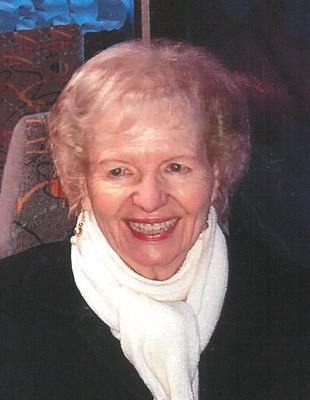![[Photos and Features]](../jpg/articlestop.jpg)
Caller Relief Donations |
A individual donation was recently given to Rochester Area Federation
(RAF) to start a fund for our callers to assist them with their loss
of income during this pandemic.
Even though it is a very generous and wonderful idea, there is no
provision in the RAF bylaws to administer it. All donations received
by RAF must be deposited in the dancer recruitment & promotion
fund.
There have been several conversations among the RAF leadership this
past week, trying to figure the best way to proceed. Presently,
neither the RAF nor the Caller’s Co-operative of Rochester (CCR)
are in a position to fairly administer a donation fund for callers and
cuers.
At this time, we are returning the donation and directing anyone
interested in donating to their callers, to please do it on an
individual basis. You may want to check with your club leadership
first, to see if anything is being planned at the club level for your
callers.
Please Take Care & Stay Safe,
Debbie & Jeff
Vice-Presidents RAF
Summer News — RAF Dancing |
Hi Everyone,
We hope you all are well & safe. Even though it’s been a
long time since we have danced together, we have great news. The
Rochester Area Federation has been busy scheduling the Free Summer
Dances and a special October DORish dance, replacing the canceled DOR
dance in May.
We are proud to announce we have 52 graduating class members from
eight clubs this year. We hope each of the graduates are
encouraged to join us on the dance floor ASAP.
The RAF dances being planned are new-graduate-friendly. Our callers
are prepared to assist the new graduates as they return to the dance
floor. The callers are well aware the classes were at varying stages
of completion when all dancing was shut down in mid-March due to the
coronavirus.
We have Free Summer Dances planned and a special Saturday afternoon
DORish Dance planned in October.
Free Summer Dances
We have three Free Summer Dances scheduled, emphasizing the
Mainstream calls, at the Henrietta Fire Hall at 3129 East Henrietta
Rd on the following Friday nights starting at 7pm:
• June 26, 2020
• July 17, 2020
• August 7, 2020
Gary Bubel will be calling and Alice Bubel will be cueing, and
arrangements for Guest callers are in progress.
DORish Dance
Date: Saturday Oct. 3, 2020.
Time: Dancing will be from 1–5 p.m.
Location: Perinton Recreation Center (PRC) same as previous DOR dances
Two dance halls: A Mainstream Hall, and a Plus/Round Dancing Hall with
a wood floor
Three callers: Mike Callahan, Dave Eno, Gil Porter
Two cuers: Jim Gotta, Mark Throne
Dance Ticket Prices: $10 at the door
We’ll have the refreshment room set up with water and hot
beverages. We are requesting dancers bring snacks to share.
There will be no dinner available at this dance.
We will be having our annual basket raffle. The baskets will be
displayed in the small room adjacent to the refreshment room. The
annual basket raffle is a key fundraiser for Rochester Area
Federation (RAF). It is the main source of funding for the promotion
of square & round dancing in the Rochester region.
There will be an RAF program including honoring our 2020 graduates,
presenting the 2020 Daphne-Norma Leadership Award, and with drawings
for the 50-50 and basket raffles.
(Important: Please let your club leaders know, a week in advance, if
you plan to attend this dance. We are not asking for advance
reservations, but we will poll clubs on September 28 for an estimate
of expected attendance.)
Distance Dancing
We extend a special Thank You to the members and clubs who are
actively promoting virtual gatherings. During this time of being
sheltered in place, it is a safe fun way to stay connected.
Thanks to Gil Porter, Brenda Bixby and Peter Emmel for arranging the
weekly Wednesday night virtual square dances: Pandemic Squares. We
have enjoyed it while discovering dancing with ghosts (or phantoms)
is more challenging than you would think. It is the closest we will
be getting to a dance floor in the up coming weeks and appreciate the
opportunity to dance very much.
We also know of several clubs that are getting together frequently or
weekly on Zoom. We all appreciate everyone’s efforts to help
our square dance members stay connected. It is so much fun to see
each other and know that our square dance friends are doing well.
Please be assured, for all upcoming dances, the RAF will be following
the current established CDC and Monroe County safety protocols.
Looking Back — DOR 1973 |
One of my favorite sources of information Rochester’s Square
Dancing history is Sally Baechle. She and her husband, Walt, started
square dancing in the early seventies, and over the succeeding decades
they became leaders and promoters at all levels.
She recently loaned me a copy of the official program from DOR
1973. Yes, in those days DOR had a printed program! It had a cover and
12 internal pages, half of which were devoted to dance information and
half were ads.
DOR 1973 was held at RIT, in the athletics building. Sally
doesn’t recall how many dancers attended, but the schedule shows
three gyms and the ice rink and lists four national callers (John
Hendron, Kip Garvey, Bob Brundage and Bud Redmond) along with two
national cuers (Phil and Norma Roberts).
Dancing started at 2pm and lasted until midnight, with a two-hour
dinner break. As now, there was dancing during the dinner
break—in this case with local callers. The program lists
Ken Boss, Stan Levandoski, Ed Butenhof, Chip Kellogg, Jerry Carmen
and Chuck Prister. (See the obituary of Chuck’s wife, Gerry, in
this issue.) All of these callers are pictured in the program, along
with other Callers Co-Op members—notably including Mike
Callahan, Jerry and Betty Carmen, and Bob Ellis.
I’ve included the schedule pages from the program with this
article, but I encourage you to take a look at the complete Program
in a more readable (PDF) format by following this link: http://squaredancingrochester.org/png/202006-DOR-Program.pdf
One interesting page you’ll find in the full program gives the
history of Dance-O-Rama up to the 1973 edition. The first DOR took
place in 1959, at Cutler Union on University Avenue. I think
it’s fascinating to look through this window to the past and
imagine all the folks who came before us and enjoyed the friendships
of square dancing.
It’s especially motivating to see the names of the many who
invested their time in helping organize events like DOR. For each of
those listed as DOR organizers, there were many more who contributed
by organizing club dances and recruiting new dancers. Thank you,
Sally Baechle for sharing these memories and reminding us of the
legacy we have inherited!
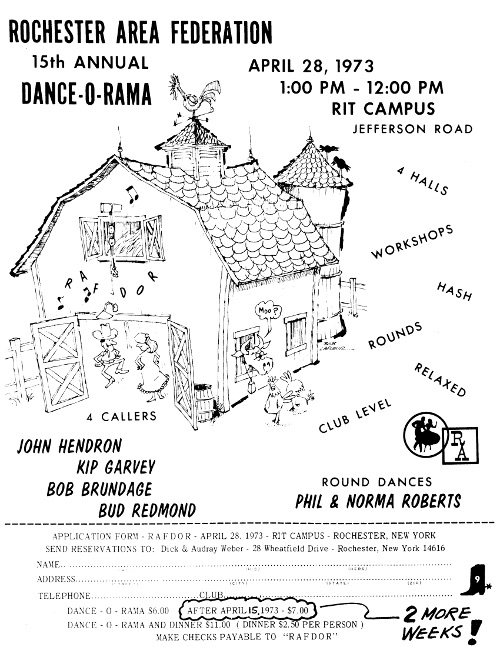
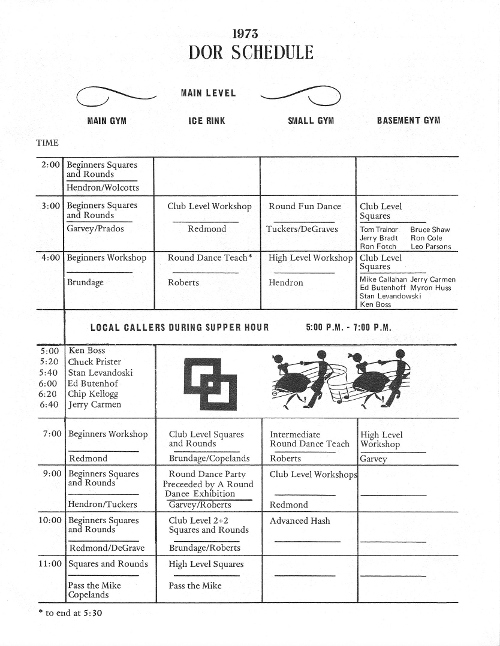
How Square Dancing Came Out of the Barn and Into the Ballroom |
(The following story about Henry Ford—yes, the
automobile magnate from Michigan—appeared in the March,
2020, issue of American Square Dancing. It was in the
“Moore Thoughts” column by Paul Moore, and is
reproduced here with permission.)
In 1923, Henry Ford visited the Wayside Inn in Sudbury,
Massachusetts, where he participated in the regular dance program of
gavotte, the schottische, minuet, and the Virginia Reel led by
Benjamin B. Lovett. Ford enjoyed the program so much he offered
Lovett a regular job to teach dancing and to train new leaders in
Dearborn, Michigan. Lovett turned down the offer because he was
contracted to the Wayside Inn. Ford, who had a personal fortune of
twenty billion dollars (in 1920’s dollars), simply bought the
Wayside Inn and Lovett’s contract. The contract was rewritten
for Lovett to come to Dearborn for two months—he stayed
for twenty-six years. During the depression of the 1930s, Lovett was
paid $12,000 per year, plus a new Lincoln every year, a home, most of
his meals and all of his transportation costs. Ford and Lovett used
the situation to promote American Square Dancing. Two hundred dancing
instructors were invited to Dearborn to learn how to dance and to
call the Virginia Reel. Lovett was also instructed to start a program
for Dearborn public school children. The dances that Lovett taught
were regularly printed in newspapers nation-wide. Every Sunday,
Lovett would travel to Chicago to call live on the radio the dances
that had been printed in newspapers the previous week—with separate broadcasts to account for eastern and western time
zones. [see Editor’s note below]
Benjamin Lovett became so busy that he had to train new dance
teachers. He developed a minimum staff of twelve to fourteen dance
instructors to help him with his ever-increasing workload. The program
kept expanding due to the generosity of Mr. Ford. Any school district
that wanted a dance program merely had to contact Benjamin Lovett,
Mr. Ford would write a check from his personal account, and Lovett or
one of his instructors would be sent to that school. Lovett, again
sponsored by Henry Ford, was responsible for bringing square dancing
and ballroom dancing to thirty-four institutions of higher learning,
among them Radcliffe College, Stevens College, Temple University,
University of Michigan, University of North Carolina and the
University of Georgia—with no charge to these
universities.
Because square dancing took more space than ballroom dancing, Ford
built a dance hall in Greenfield Village, site of the Henry Ford
museum. It was beautifully decorated with chandeliers and had a
hardwood floor that would hold approximately forty squares of
dancers. Ford even hired one man, full-time, to polish the floor
daily, whether the floor had been used or not.
In 1926, Henry Ford published an excellent book on American Square
Dancing entitled “Good Morning.” The title page
states: “After a sleep of twenty-five years, old fashioned
dancing is being revived by Mr. and Mrs. Henry Ford.” In the
archives of the Henry Ford Museum, several written accounts of former
executives report that Mr. Ford invited all of his executives to take
lessons in early American Square Dancing. He was quick to tell them
that he wanted them to take these lessons of their own free will, and
not be under any pressure. However, an invitation from Mr. Ford was
tantamount to a command from royalty.
Benjamin Lovett was a strong leader in early American Square
Dancing. He was the personification of a gentleman. Regardless of the
fact that most of his dancers were people of great wealth and
position, he told them what they were to wear and what they were not
to wear.
He insisted that the ladies wear formal dresses and corsages. Men were
told that they were to wear dark suits. The ladies were instructed
that they never were to cross their legs at the knees, but only at the
ankles. And no one could cross directly across the dance floor except
Mr. Ford.
When Ford passed away, Lovett could no longer afford the promotion of
square dancing. In 1949 he announced his retirement and he left
Michigan, never to be seen there again. He died in Massachusetts in
1951.
Editor’s note:
According to Wikipedia, the National Barn Dance was broadcast by
WLS-AM in Chicago, Illinois, starting in 1924. It was one of the first
American country music radio programs, and a direct precursor of
Nashville’s Grand Ole Opry. After 44 years, the show aired its
final Barn Dance in 1968.
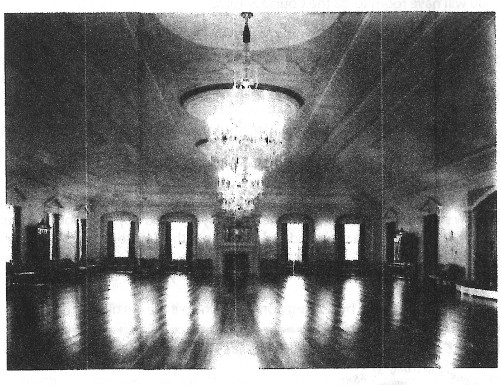
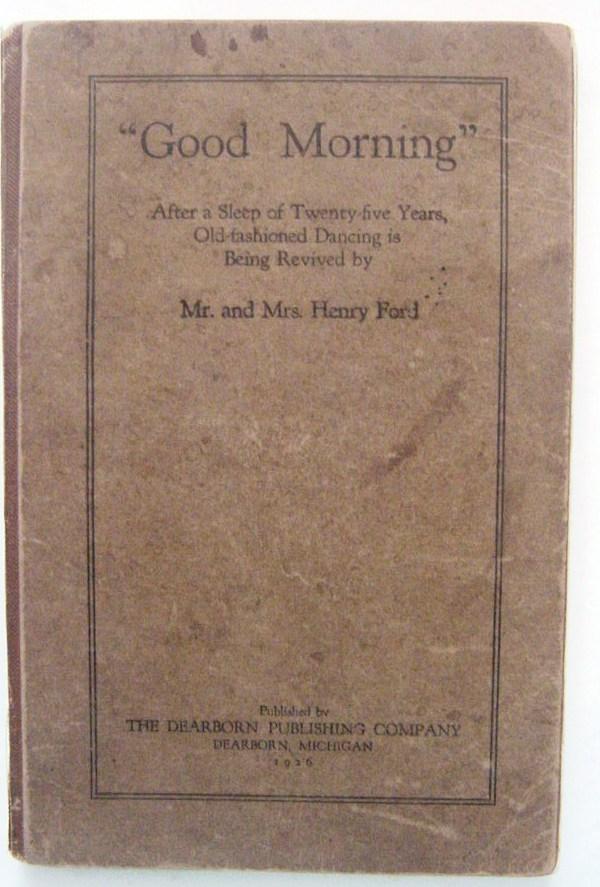
Tip Sheet — Distance (Video) Dancing |
The coronavirus pandemic has forced most of us apart and indoors, but
that doesn’t mean we have to stop dancing!
In normal times, dancing is good exercise and it keeps us in touch
with our friends. Now, in the isolation of “social
distancing” we need those things more than ever.
A few adventuresome callers and dancers are filling this unexpected
gap by harnessing video conferencing technology. One of these
pioneers—the Pandemic Squares—was
organized by Brenda Bixby, with Gil Porter calling. They dance at
8pm on Wednesdays. Contact Brenda at brendabixby152@gmail.com for
login information.
Early “Zoom Dances” are identifying what works and
what doesn’t. In this edition of the Tip Sheet, we’ll list
some of the key Dos and Don’ts.
First a few basics. What we are talking about is a type of internet
application (app) that runs on any internet device, be it a computer,
laptop, tablet or smart phone. It uses the camera and the microphone
in your device to bring your live image and voice to the screens of
all the others who are participating in the same session.
Images from the other participants are simultaneously displayed in a
grid array on your screen, and audio from their microphones plays
through your speakers. So, you can all see and hear one another at the
same time.
In distance dancing, a caller in the same session plays music and
calls tips, while the other participants listen and dance in front of
their devices, usually in pairs or singles. To keep ambient sounds of
dancers from disrupting the music and calls, the
“host” mutes all but the caller’s audio during
each tip, then un-mutes everyone for conversation between tips.
This is a great way to keep dancing in these housebound times, but it
poses special challenges for the caller and for dancers. For one
thing, the caller doesn’t get the feedback of seeing squares of
dancers on the floor. Also, the dancers have to interact with
imaginary “ghost” dancers for most of the calls.
This is more fun than you might think, and even if you are skeptical,
there’s no harm in trying it. Keep in mind that
“dancing is friendship set to music,” and remember
that the alternative to this is to sit at home in isolation!
One good aspect of dancing this way is that ghosts don’t roll
their eyes and make you feel bad it if you break down their
square—at least I’ve yet to hear one complain!
Following are a few tips to help you get up to speed on this new mode
of dancing.
Do:
• Take some time in advance of the session to set up your device
and dance area so that you are happy with the view seen by the
camera. (Use an app like FaceTime to see your image and adjust the
aiming.)
• Set your internet device in a place where you can dance in
front of it on a hard floor. You’ll need, at minimum, an area of
about 6 feet square, with its front edge about 4 feet in front of your
device.
• Set your device on a countertop or a table, maybe on a box
or a cushion, to get it about waist high, and aim the camera slightly
(but not too far) above horizontal.
• Mute your microphone. Sounds you make while dancing can
interfere with the caller’s audio and the music. The caller
might ask for comments after each tune. Then you can un-mute to ask
questions & talk with friends. (The host often takes care of
this.)
• Imagine there is one ghost couple in their normal place
opposite you or beside you, or wherever they should be for the
configuration you are in. For example, in an Ocean Wave with you and
your partner facing the same way, you will be holding hands with a
ghost between you facing the opposite way—and one of you
will be holding a different ghost with their other hand as well. (See
accompanying diagrams for typical configurations.)
• Note that, since most moves will be do-able as a box of four,
you can do this with only one ghost couple, i.e., you don’t
have to imagine three other couples. Callers will (hopefully) avoid
full-square calls such as Grand Square, Load the Boat and Relay the
Deucey.
Don’t:
• Don’t worry about getting everything right. This is new
to everybody and all are learning how to dance with ghosts. Also, most
folks are so focused on their own dancing that they are not watching
you, so nobody knows if you are doing what the caller is calling or
doing your own variations on it.
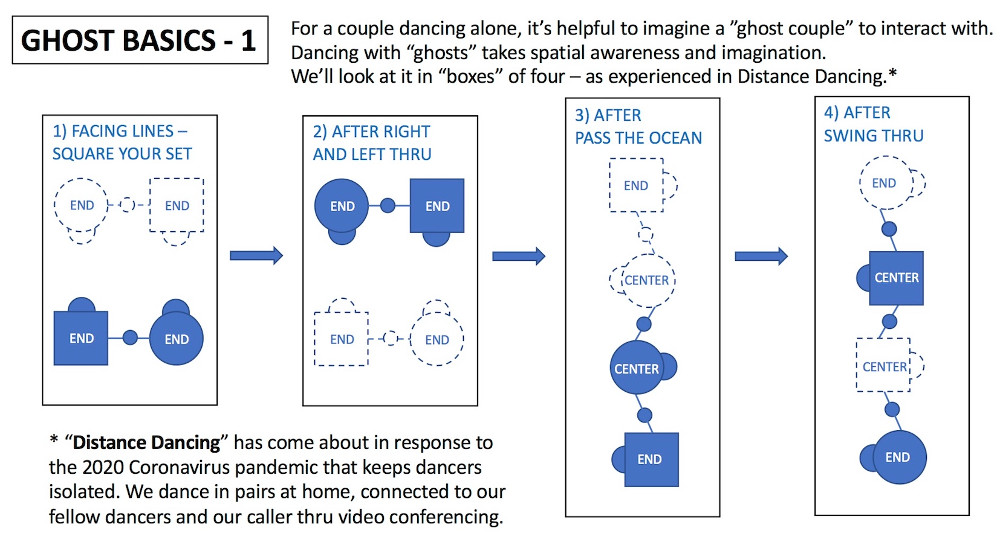
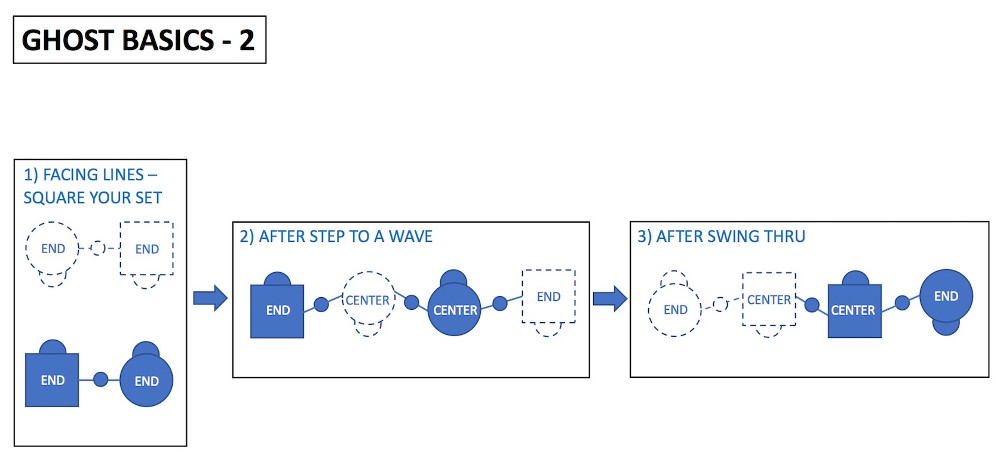
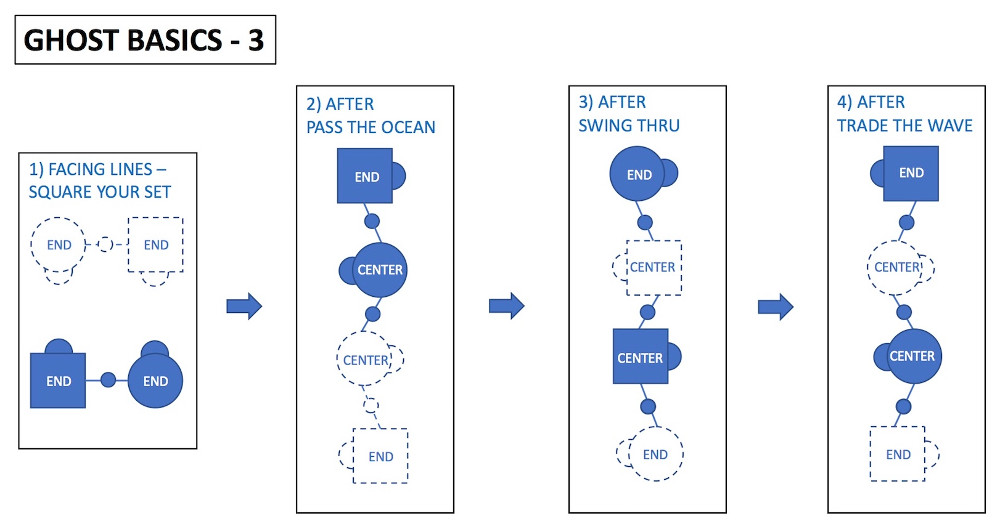
Cloverleaf Squares 50th Anniversary Dance |
Just before the cusp of the Coronavirus (COVID-19) lockdown,
Cloverleaf Squares held an event for their fiftieth anniversary. 530
invitations were mailed out. 130 people registered to attend, and 126
signed up for dinner. Nancy Tompkins headed the planning committee to
find a venue, arrange for the menu, and manage the mailing
list. People were looking forward to the dance and reunion. But there
began to be a concern about the possibility of spreading or receiving
the virus. Happy with the health safety commitment of the venue, the
Diplomat Banquet Center, Cloverleaf Squares decided to hold the dance
after all.
And what a ball did they have! Current and former members gathered for
dinner and a dance. Although Mike Callahan was not able to fly during
this time, Dave Eno took his place as the dance caller. Linda Liberti
was already in the area from Arizona and was able to lead them in
round dancing. In attendance were former members such as Bob Sponable,
our 1970 club president, and Ann Crowley-Hash, an original class
member.
Take a look at all of their pictures on the Cloverleafs’ website
at http://www.cloverleafsquares.org/Pictures.htm. You will see old
friends, Rochester area dancers, and new dancers. There are pictures
of dancing, and eating, and visiting. Their anniversary dance and
dinner was a hit. Is it time to plan for their 100th anniversary?
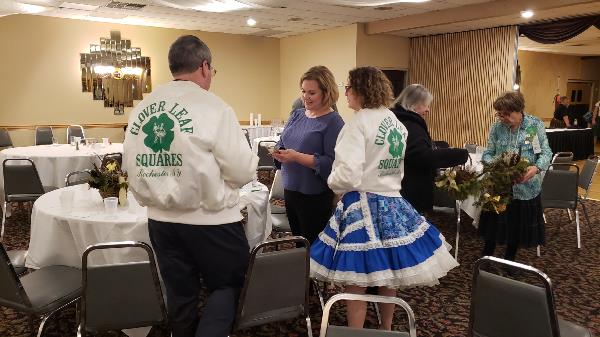
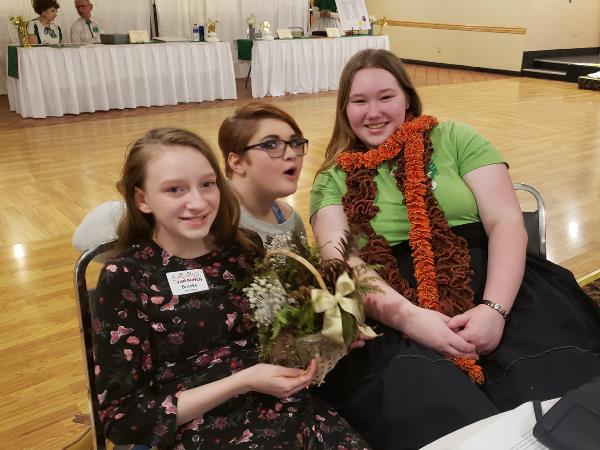
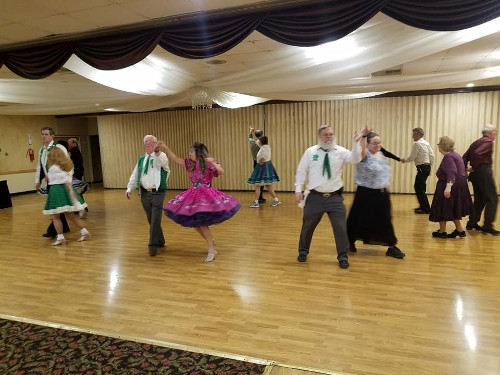
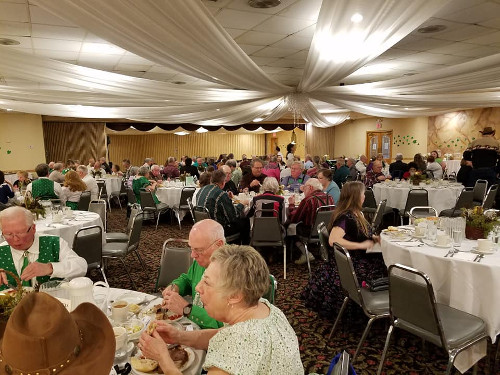
Rochester Area Federation Update |
At its April 2 meeting, the Rochester Area Federation of Round and
Square Dance Clubs (RAF) elected its officers for the coming season
(July 1, 2020, thru June 30, 2021):
Presidents—Debbie Blood and Jeff Blood
Vice Presidents—Ann Granger and Sue Sepkowski
Secretaries—(open—seeking willing
volunteer—couple or single)
Treasurers—(continuing) Rick LaDonna and Donna LaDonna
Promotion Coordinators—(continuing) Amy Aeckerle and Kris
Aeckerle
Thank you to those out-going officers who served for the past year,
Jim Gotta (President 3 yrs) and Gary & Lorraine Granath
(Secretaries 2 yrs), and to those who have stepped up, or re-upped,
for the coming year. We look forward to “interesting”
times, as the entire dancing community—dancers, clubs
and callers—learns to navigate the challenging terrain of
the coronavirus pandemic. These folks will be looking to facilitate
the return to dancing in our area as safely and as soon as
possible. (Please read Jim Gotta’s “President’s
Corner” message in the Federation section of this website.)
In addition to electing its 2020–21 officers, the RAF board
carried out a mandated periodic review of its By-Laws. A final vote on
adoption of revisions was tabled until the next meeting, on September
9, in order to incorporate final details. Besides clarifying
operational and organizational features, the By-Law revision
reinforces the RAF’s dual purpose:
- to promote and maintain interest in western-style round & square dancing in the Rochester area, and
- to foster a collaborative spirit among affiliated square dance and round dance clubs.
These meetings address the following areas of RAF responsibility:
- Marketing and coordinating promotional activities with RAF clubs
- Arrangements for RAF events, including Dance O Rama and other multi-club events
- Grants and reimbursements for your club’s dancer recruiting and retention efforts
- Dancer insurance for every member club
- Any issues with the RAF website (schedules and listings) or the Promenader (news, photos and articles)
Getting Together While Apart |
In these times of forced separation, many area dancers are
“getting together” via internet video. Three that I know
of are pictured here. They are the combined Belles ’N’ Beaus and
Silver Squares (Mondays at 6:30pm), the Village Squares (Wednesdays at
7pm) and the Pandemic Squares (Wednesdays at 8pm).
The first two of these are social gatherings, to say hello and catch
up with square dancing friends. Joining is easy from a smart phone,
tablet or computer. You can also call in from any phone, but a few
have had trouble with passwords by phone.
The Pandemic Squares, organized by Brenda Bixby, with caller Gil
Porter, includes actual dancing! Yes, we can dance
“together” while we are all in our own homes. The Zoom
video conference platform makes this relatively easy—well, I mean the connection is easy. The dancing takes some getting
used to—and some imagination.
Elsewhere in this issue you’ll find a “Distance
Dancing” installment of the Tip Sheet. The challenge for dancers
is to imagine the “ghost” (or “phantom”)
dancers in your set. A set consists of two couples in a box of
four. In our COVID stay-at-home state, that means we each have to
imagine the other couple—or if we are dancing solo, we
also have to imagine our partner.
The best thing is that phantoms don’t complain when we screw up!
(Scroll to the Tip Sheet for guidance on getting started dancing with
ghosts.)
Another way that dancers are getting together is by taking coordinated
walks in area parks. Don Felice and others have organized walks in
Highland Park and Durand Eastman, and maybe others. With appropriate
protection (i.e. masks and distancing) there’s no reason that
these can’t be safe and enjoyable—especially now
that the weather seems have finally turned the corner to spring.
If you would like to be included in any of these activities, send
email identifying which event(s) you are interested in to
promenader@rochester.rr.com and we will forward to the appropriate
organizer.
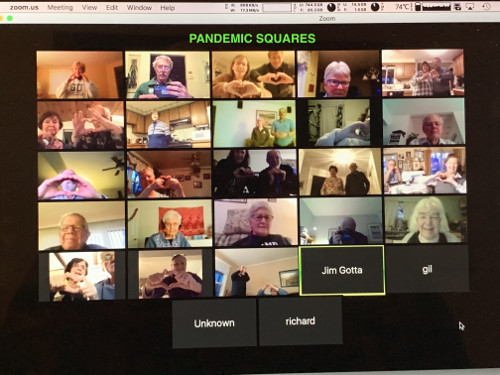
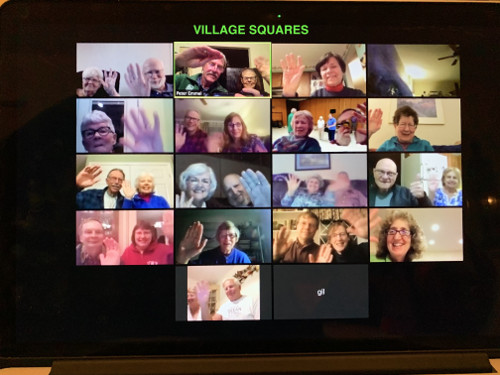
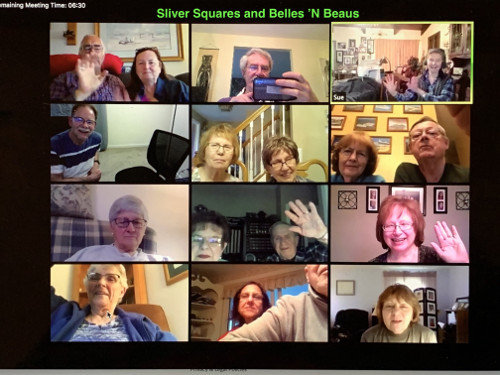
Alert for Club Leaders About Insurance for Class Members |
Remember that insurance for graduates covers only nine months of class
lessons—originally September (2019) thru May
(2020). However, that was before COVID took over and dancing was
interrupted in March, cutting off 3 months of classes.
When dancing resumes, if you decide to do any make-up
classes—during the summer, or fall, or whenever dancing
resumes—these “graduates” can remain covered,
but ONLY IF you apply for an extension by sending me the following
three dates:
- the date of your first class (Fall, 2019), and
- the date of your last class before the pause and
- the date you are resuming classes.
The fee for insuring each new club dancer is the same—$4.80 per person with a check made out to USDA and mailed to me. My address is 350 Fishell Road, Rush, N.Y. 14543.
To request an extension of coverage, please email me the above information and I will notify USDA for each club.
Gerry Davis (Prister) Bolton |
Gerry Davis Prister Bolton passed away peacefully in Fairport on April
18, at age 93. She is survived by daughter Julia (Russ) Harper, son
Kurt Prister and grandchildren Andrew & Kelly. A memorial will be
held at a later date. (Visit caringbridge.org)
Donations may be made in Gerry’s memory at rph.org
Obituary published in Rochester Democrat And Chronicle April 25 &
26, 2020.
Gerry and her first husband, Chuck Prister, were active square
dancers in the Rochester area. In 1977, they were the very first
recipients of the Daphne-Norma Leadership Award, presented by the
Rochester Area Federation of Round and Square Dance Clubs. They were
active in the EKC-O Squares (formed by Kodak employees) and the
Genesee Dancers. Together, Gerry and Chuck designed the EKC-O Squares
badge logo. Chuck was a popular guest caller who also taught square
dancing for the Copy Cats, which had been formed by Xerox employees.
The accompanying photo shows them at a Genesee Dancers Christmas
dance. They had just been presented with a poster titled “Your
Face in the Crowd” by Walt and Sally Baechle.
(Please see the accompanying profile of Chuck—and
Gerry—from the April, 1973, issue of the Promenader.)
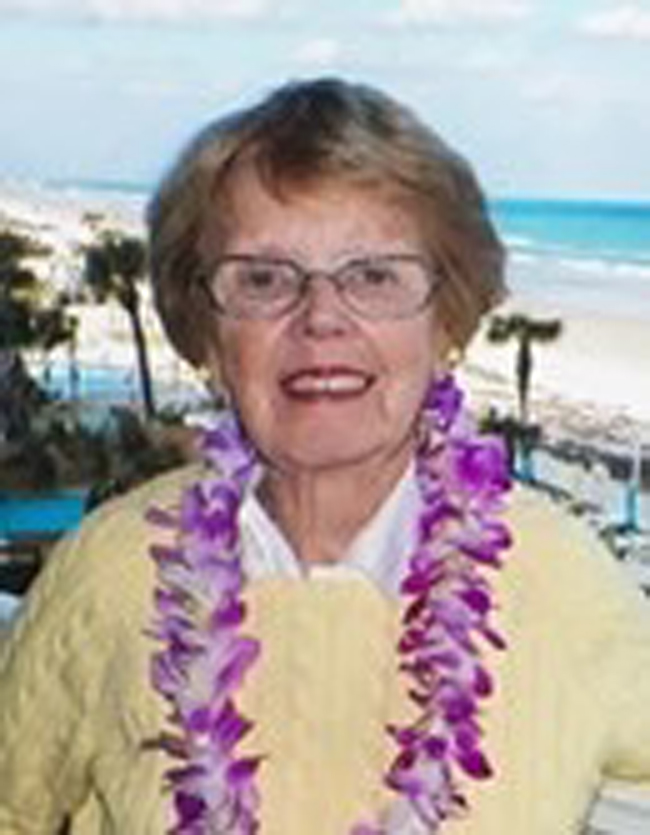
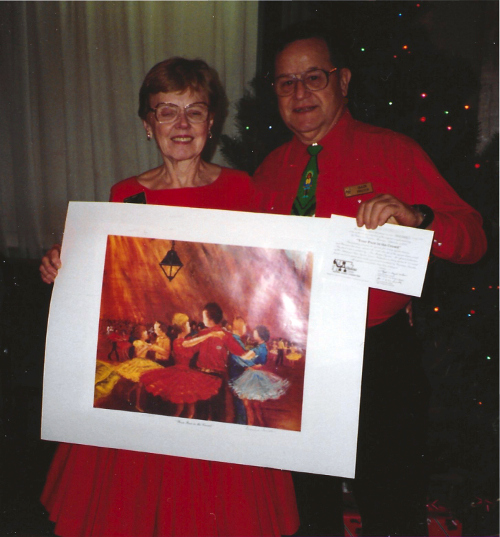
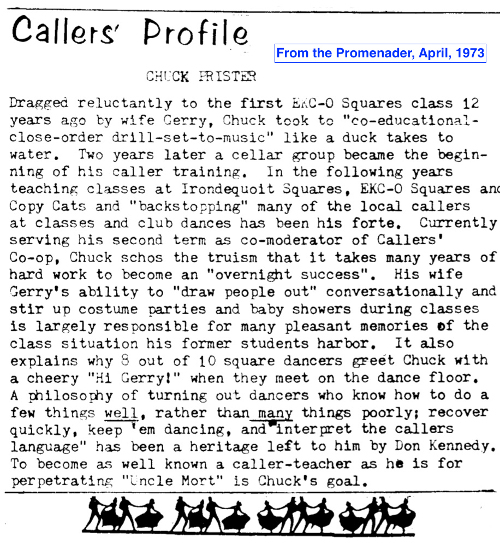
Mary Donadoni Salvione (Elmer) |
On Tuesday, May 5, 2020, Mary Salvione, loving wife and mother, passed
away peacefully at age 87. Mary was born on September 4, 1932 in
Rochester, NY to William and Gertrude (Aman) Donadoni. Mary grew up in
St Andrew’s parish and school. She graduated from Our Lady of
Mercy High School in 1950.
Mary raised eight children with Walter Elmer in Chili, New York. Mary
was proud of her big family. She enjoyed playing games, especially
dominoes and cards. Mary was a sharp euchre player to the end. She was
an avid Scrabble player and enjoyed the Daily Jumble puzzle. Mary had
a special gift for baking and was known as “Mary, Queen of
Desserts” by her children. She had a special knack for making
desserts out of creative combinations including chocolate syrup on
Cheerios and marshmallows toasted on Ritz crackers. If it were up to
her, any kind of chocolate would do.
Mary’s hobbies included playing piano, crocheting, sewing, and
reading. Mary was a secretary at the University of Rochester School of
Nursing; she retired in 1997. She married Arthur Salvione in 1993. For
18 years, Mary and Art spent winters in Oldsmar, Florida, where they
enjoyed square dancing and social events. She was a devout Catholic
and faithful communicant. One of her many acts of service was
volunteering at Birthright.
She was predeceased by her parents, husband Arthur, brother George
Donadoni, sister Dorothy Maier, son Mark, daughter Lucy Sulkowski, and
son-in-law Michael Smith. She is survived by her children; Jean Smith,
Margie, Bill (Judi), Cathy Raksha, Maria Elmer, Dolores (Tony) Gratto,
grandchildren; Brian (Sara) Bickersmith, Colleen (Shaun Baxter) Smith,
Jackie (Victoria) Woodward, Stephen, Andrew, and Hannah Sulkowski,
Claire and Michael Gratto, and great-grandchildren Violet and Mira
Bickersmith, her brother, Alex (Sally) Donadoni, brother-in-law David
Maier, and sister-in-law Lorraine Donadoni, many cousins, nieces and
nephews.
Due to COVID-19 restrictions, funeral services will be held at a
future date. As an expression of sympathy, please consider having a
Mass offered for Mary’s soul at St Elizabeth Ann Seton Church,
3747 Brick Schoolhouse Rd, PO Box 149, Hamlin, NY 14464 or contribute
to a charity of your choice.
Arrangements have been made by Rochester Cremation.
To Plant Memorial Trees in memory, please visit our Sympathy Store.
Published in Rochester Democrat And Chronicle May 8–10, 2020.
Mary and Art were members of the Cloverleafs square dance club.
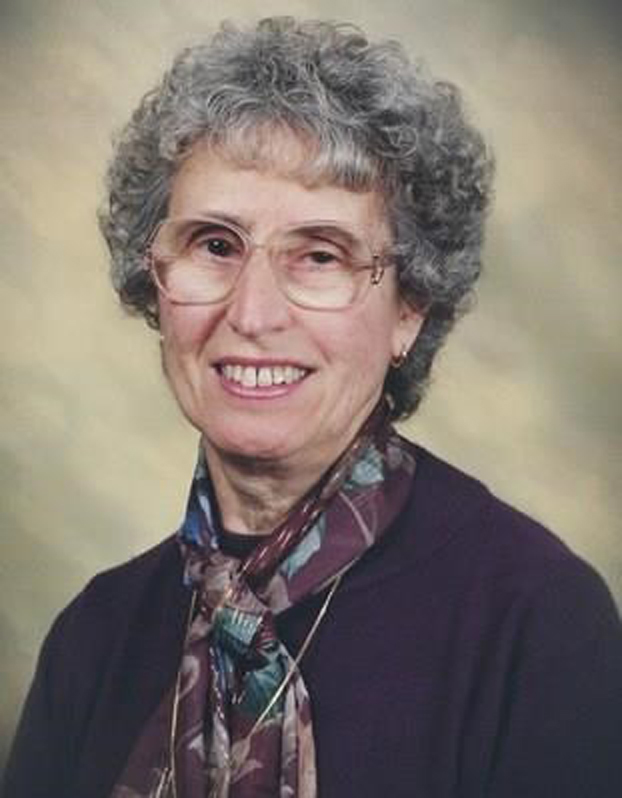
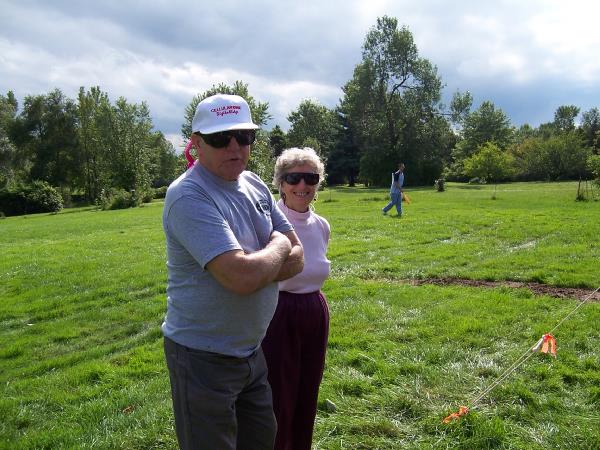
Joilee “Joy” Mulhern (Collins) |
Pittsford—Peacefully in her sleep, during a long recovery
from aspiration pneumonia, May 10, 2020, at age 86. Joilee is survived
by her special friend and caregiver, Ronald C. Anderson of Pittsford;
daughter, Jill Mulcahy (Jason) of Webster; special daughter-in-law,
Christine Clendenning of Irondequoit; grandchildren, Jake Mulcahy,
Emily and Josh Clendenning; and her special sister-in-law, Betty
Rund. She is also survived by many cousins and countless friends
everywhere. Joy was predeceased by her parents, Ed and Dorothy
Collins; her special friends, Gill Crayton and John Pratt; and by her
special uncle, Guston Joseph DeMeyer.
Joy was born on March 9, 1934 in her family’s home on Stonewood
Avenue in Greece. Living in the then free school district, she
attended #42 School on Lake Avenue and Charlotte High School,
graduating in 1952. It was in kindergarten at #42 School that she
first med Ron Anderson. Joy worked a variety of jobs during her life,
including at Rochester Telephone Company and Eastman Kodak. During her
married life, Joy lived on Buffalo Road in Churchville. She later
moved to Trimmer Road in Spencerport, and finally, about 25 years ago,
to her town house in Pittsford.
Joy was an extremely outgoing person, and made friends everywhere she
went. She could “work a room” in world class fashion! She
was very active in line dancing, square dancing, and card playing,
especially bridge, euchre, and pinochle. She traveled extensively, her
favorite trip being to Australia and New Zealand. She was very active
in the Pittsford Senior Center, and helped host it’s semi-annual
euchre tournaments recently. Joy was on the board of the Flower City
Jazz Society, and acted as the hostess for its monthly dinner
concerts. Joy was also the “glue” that held together the
Charlotte High School class of 1952, and was centrally involved in
putting on reunions every five years, including the most recent one in
2017, as well as countless informal get-togethers with classmates in
between.
Because of the current pandemic situation, a Memorial Mass for Joy
will be held on a date to be determined at St. Catherine of Siena. In
lieu of flowers, contributions may be made to St. Catherine of Siena,
26 Mendon-Ionia Rd., Mendon, NY 14506; McQuaid Jesuit High School,
Advancement Department, 1800 Clinton Avenue S., Rochester, NY 14618;
Mercy Bridges, 1437 Blossom Rd., Rochester, NY 14610 or charity of
choice. To share a memory of Joy or send a condolence to the family
visit www.anthonychapels.com.
To Plant Memorial Trees in memory, please visit our Sympathy Store.
Published in Rochester Democrat And Chronicle from May 11 to May 12,
2020.
Joy was a square dancer off and on for about 30 years, most recently
with the Cloverleafs and the Grand Squares. Carol Ann Stahl, from the
Grand Squares, submitted the following remembrance:
Initially Joy danced solo with us, but several years ago she
partnered with Ron Anderson and they attended most dances together.
She was our club’s Promenader reporter for several years, keeping
the Square Dance Community aware of our activities. She was always
ready to greet fellow club members and guests with her friendly
smile. The fact that our dances were held on Thursday evenings was a
plus and a minus as far as Joy was concerned. Since she often hosted
the weekly euchre games at her home on Thursday afternoons, we were
the recipient of her leftover (and delicious) refreshments. But as
her health worsened, it became more difficult to combine the
afternoon and evening activities and unfortunately it was the square
dancing that suffered. We were grateful her presence when we had her.
